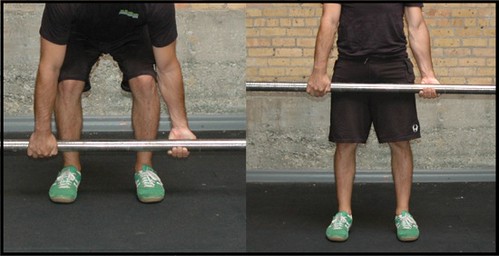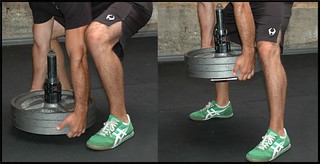A few weeks ago I received an email from a DPT student in central Florida detailing a research project that he’s doing alongside a fellow student (as well as with one of the faculty at his school) looking at ways to use the deadlift pattern to treat patients with low back pain in a therapy setting.
He asked if I’d be willing to provide some common cues I use given certain “issues” people have when trying to deadlift which would aid in correcting their technique.
[Places finger over said student’s mouth]
Shhhhhhhh, you had me at deadlift.
What follows below is a candid/informal list I sent back highlighting my thoughts on more of the cueing side of things rather than the actual “correctives” (Ie: mobility drills, soft tissue restriction, chewing with your mouth closed, etc).
At the very least I figured it was something that could potentially help out others who may be looking to clean up their own technique.
And if it doesn’t, my bad. I tried.
Lumbar Kyphosis
Depending on one’s kinesthetic awareness, this one can be tricky. For those completely unaware of what their body is doing in space I’ll most likely take a more “hands-on,” non-Creepy McCreepypants approach – akin to what I call Play-Doh coaching.
Lets just say I’ve seen some trainers and coaches get a little too hands-on, if you’re catching my drift.
More often than one would think, you’re going to tell someone to “arch their back,” and then they’re going to look back at
you as if you’re speaking Klingon or have an extra nipple or something. Not that you’d be showing off your nipples or anything, hence the whole creepy comment above, but I’m just trying to make a point.
They’ll literally have no idea or differentiation between lumbar flexion and what it means to arch their back.
One trick I like to use is to place them on the floor in the quadruped position and have them perform the cat-camel. I’ll have them round their back as much as possible and tell them that’s what I DO NOT want.
Sometimes, depending on the severity, I’ll place my hands on my head, scream as loud as I can “no no no no no no NO!” and then jump through a pane glass window.
You know, for a little more effect. That’ll get their attention…..;o)
Back in reality, though, I’ll then have them bring their spine back to neutral and tell them that’s what I’m looking for. I’ll have them perform a few rounds of this just so that they’ll get a feel for what I want and who I’ll want them to set up to deadlift.
It’s pretty effective, and will work for most trainees.
Another one I’ll use is to tell them to emulate what a basketball player does on the court when he’s tired (bends over and places his hands on his knees). Almost always, they’ll drop right into a neutral spine position and then I’ll be like, “there!” Now, keep that same spinal position and grab the bar.
Another thing to consider is just using a deadlift variation which allows them to be successful. I’ve long championed that what makes the deadlift so awesome is that it can be so easily catered to the lifter, and not vice versa.
This is a huge reason why I love the trap (hex) bar so much, as it lends itself to be a bit more user friendly compared to other deadlift variations. This is especially true for those who lack ample ankle, hip, and t-spine mobility to get into proper position in the first place.
With the elevated handles (and the fact that their center of gravity is inside the bar), the trap lends itself very appropriately to beginners or those with postural limitations.
Anterior Weight Shift
The main culprit here is people wearing those cement blocks that they call shoes. Many have a significant heel lift which shifts the body anteriorly and makes it much harder to engage the posterior chain (glutes and hamstrings).
In addition, wearing shoes also increases the distance the bar has to travel, so it bodes in one’s favor to just ditch them altogether.
If for some reason they train at a gym that sucks and won’t let them deadift barefoot, I’d highly recommend things like Chuck Taylor’s or the New Balance Minimus (which, as the name implies, is more of a “minimalist shoe).
Outside of that, much of the resolution here is engaging a proper hip hinge pattern.
Having the ability to break with the hips and engage a hip hinge pattern – without losing spinal position – is HUGE in this context.
My go-to drill is hinging with the dowel rod. We’re looking for three points of contact – back of the head, in between the shoulder blades, and the sacrum.
If at any point the dowel rod loses contact with the body, you’re doing it wrong.
I may have them perform a set of 8-10 reps with the dowel rod, and then immediately have them walk over to the bar and try to emulate that same motion. We need to CEMENT the pattern with strength training.
Along those same lines, another drill I use sporadically is where I tell them to pretend I have a rope tied around their waist and that I’m standing behind them and when they start their descent to imagine that I’m pulling their hips back with the rope.
It sounds weird and far too simple – but it works.
Limited Dorsifexion
This is an often overlooked limitation, as you need roughly 15-20 degrees of ankle dorsiflexion in order to perform a squat, lunge, and deadlift pattern without any major compensation up the kinetic chain.
Your garden variety ankle mobility drills are going to work wonders here.
Knee Break Ankle Mobs:
Wall Ankle Mobs:
Band Hip IR/ER with Ankle Mob (kill two birds with one stone here):
Some other things to consider, however:
1. We live in PLANTAR flexion. Think about all the women who wear high-heels day in and day out, not to mention the aforementioned “cement shoes” that a lot guys opt to wear. I love high-heels as much as the next guy (looking at them, not wearing them. Just wanted to clarify).
Oh……my……..god…..I love them so much…
…..but I can’t even begin to describe how much of a train wreck they are in terms of the compensation patterns they elicit. Everything from chronic low back pain to plantar fasciitis to bone spurs.
It’s pretty telling how much they mess women up, and I’m often advocating for most, when they can, to ditch the high heels in light of wearing a flatter shoe.
Likewise, for dudes, purchasing a more minimalist shoe will work wonders in the long run.
2. Dedicated stretches for the gastrocs and soleus muscles are going to be imperative here as well. Standing around in plantar flexion all day is going to light these muscles up, so taking some time to do some simple stretches would be advantageous.
3. On that same note, I’m willing to bet that most even sleep in plantar flexion! It sounds excessive, but even something like utilizing a Strassburg Sock – which encourages more DORSIflexion while you sleep – pays huge dividends in the grand scheme of things.
As an aside, I’d also gravitate more towards trap bar and sumo variations for those with limited ankle dorsiflexion and those will be less problematic postions to get into.
Limited Glute Activation/Weakness
This one is pretty easy. I’ll often defer to my good friend, the glute-master himself, Bret Contreras and place a premium on glute activation drills prior to training whether it’s supine bridge variations, single-leg variations, etc.
In my mind, glute activation drills is something that most people can’t get enough of so I have no qualms telling people to do them every day, several times throughout the day.
The key, of course, is to ensure that they’re doing them correctly. Again, proper coaching comes into play here.
Moreover, in the context of deadlift technique, you have to be cognizant of a few things as you’ll inevitably come across two common errors.
1. Incomplete or no hip extension what-so-ever.
Note: for some reason I didn’t have a video available for the DL, but Eric does a good job of showing incomplete hip extension with this squat variation.
2. Excessive HYPERextension (essentially using lumbar hyperextension for hip extension)
In both cases proper cueing is going to be paramount.
For the former I’ll typically tell them to “finish with glutes” or “hump the bar,” which usually gets the job done. Also, depending my rapport with the client, I’ll literally place my hands around their pelvis and try to encourage more posterior pelvic tilt. Too, I may gently tap their glutes to help them fire.
In the case of the latter it’s a bit trickier, but I like to tell them to “finish tall,” and again, depending on the rapport, I’ll place my hands around their pelvis to help them but on the brakes (and prevent them from going into too much hyperextension).
Thoracic Kyphosis (keep in mind we’re just using the movement to influence lumbosacral movement, not trying to lift maximal weight)
Honestly, the dowel rod drill from above is going to be great here. As well, I’ll cue guys to make sure they stick their chest out upon the initial set-up which will encourage a bit more t-spine extension
I pretty much shot from the hip on all of these, but hopefully they all made some sense and help a few people out.
Seriously though, I love high heels.


 thin plate or two and then load a few heavier plates on the loading pin, and finally lock down the apparatus with the collars on the top. Straddle the load, slide your fingers underneath both sides of the bottom plate, and lift it up a few inches. Be careful when you set it down to do it evenly so as to not crush your fingers.
thin plate or two and then load a few heavier plates on the loading pin, and finally lock down the apparatus with the collars on the top. Straddle the load, slide your fingers underneath both sides of the bottom plate, and lift it up a few inches. Be careful when you set it down to do it evenly so as to not crush your fingers.

